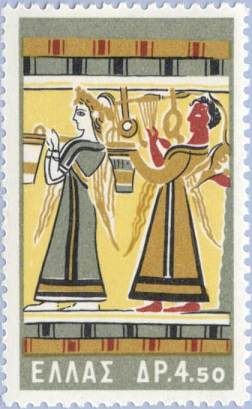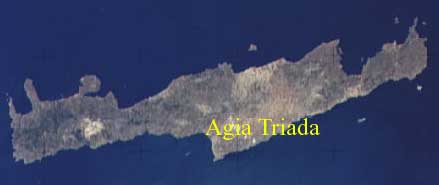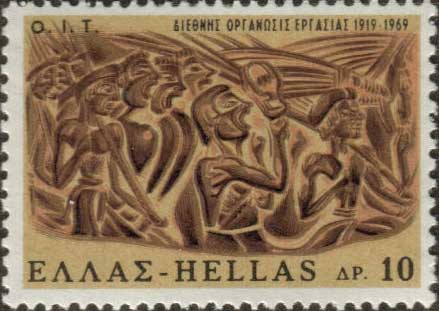.
Set like a jewel in the wine dark sea there lies a land called Crete, a rich and lovely land, washed by waves on every side…. Homer, Odyssey, XIX

The Agia (or Aghia) Triada Sarcophagus fresco. Sarcophagus means flesh-eating. The limestone of the sarcophagus caused the rapid disintegration of its contents, giving the coffin its specific name. A Minoan Fresco (1450-1400 BC) of a painted stone sarcophagus with scenes from a funerary rite, Iraklion Archaeological Museum. Top a deceased in the right side with men bringing gifts, two women on the left pour a libation. A lyre player is shown and in the bottom an aulos player. The Fresco looks like a Egyptian Fresco, except the women who have a white skin color.
From a Lecture:
"The paintings are gay and delicate and at the same time very solemn, for they describe the sacrificial ceremonies for the dead prince who once lay in the sarcophagus. Nothing has been lost, …. The colors have faded a little, but only a little — there are startlingly fresh madders, rose pinks and emeralds. There is a sense of movement and life. The sarcophagus dates from a period long before the building of the palace of Knossos, and is therefore the oldest European painting to have survived. .. What is astonishing is the sense of immediacy established by the unknown artist… the ceremony… takes place before our eyes.’

"On one of the long sides of the sarcophagus a bull tied with brilliant scarlet ropes to an altar has just been stabbed. The blood is dropping into a bucket. A priestess blesses the dying bull and procession moves toward the altar surmounted by a double ax. That is all, but the brightness of the blood and the slow march to the altar are wonderfully depicted."

The reverse side depicts "the great two-handled urn which will receive the blood of sacrifice offered by the priestess. There follows a woman with a strange bird-shaped crown, who carries two baskets over her shoulders; these baskets contain the thighs of the bull, which will be burned perhaps on the steps of the columns crowned with the double axes. Behind this woman comes another, the most stately of all, who plucks at a seven-stringed lyre with a plectrum. From these women fall rippling banners in the shape of feathers, announcing they are the servants of the goddess represented by the dark bird."
To the right of the lyre player the scene abruptly changes. Three priests wearing sheepskin skirts are bearing offerings to the dead — two bundled calves and a long curved boat. They are set against a darker background, signifying perhaps a journey into the earth, into the darkness which opens out on a sacred grove where another altar stands. In front of this altar, calm, impassive, stands the lead man, wearing a striped shroud. His feet are hidden, so that he give the impression of slowly emerging from the darkness at the summons of the priests who come with their offerings."
"At one end of the perfectly balanced panel … [is] the blood of sacrifice falling in the sacred urn, at the other end … [is] the dead man rising in the sacred grove. As the blood is poured, so life flows in the dead. Unmistakenly the panel portrays a resurrection, the long-wished-for return of the young prince who died about 2040 B.C."
On these painted panels there is no confusion, no attempt to over-dramatize the figures. The three women and the three men move with an enviable dignity and grace, with a naturalness which betrays the emotion of the artist. There is solemnity, but there is also a quiet joy in the expectation of deliverance from death. There is the faintest suggestion of Egyptian and Assyrian influence in the stern profiles of the priests, in the long eyes, in the sheepskins belted at the waist, but the women are wholly European, robust, high-breasted ,swinging their heavy skirts…" [Robert Payne, The Splendor of Greece (New York: Harper and Brothers, 1960), pp. 27-29.]

Stamp with a scene from the Fresco. Are these both women or is there a convention that women are shown in white color, whereas men in dark red?

A Minoan Priestess (c. 1700 BC) reconstructed anatomically from a skull (John Prag and Richard Neave ). My colored version. According to a story she was killed due to an earthquake while carrying a human sacrifice!

Agia Triada, Crete Greece, Minoan Crete Map

Scene from a Minoan Vase, Agia Triada ("The harvester vase").
Information and Images from Agia Triada , Image of the Sarcophagus , A closer look at a priestess
A female sculpture from Agia Triada (with many breasts ??)
Aghia Triada (English Version) ( Greek Version )
THE 147 CITIES OF ANCIENT CRETE (ΟΙ 147 ΠΟΛΕΙΣ ΤΗΣ ΑΡΧΑΙΑΣ ΚΡΗΤΗΣ)
A Colored Sarcophagus (400-375 BC)
| Ancient Greece
Science, Technology , Medicine , Warfare, , Biographies , Life , Cities/Places/Maps , Arts , Literature , Philosophy ,Olympics, Mythology , History , Images Medieval Greece / Byzantine Empire Science, Technology, Arts, , Warfare , Literature, Biographies, Icons, History Modern Greece Cities, Islands, Regions, Fauna/Flora ,Biographies , History , Warfare, Science/Technology, Literature, Music , Arts , Film/Actors , Sport , Fashion --- |

